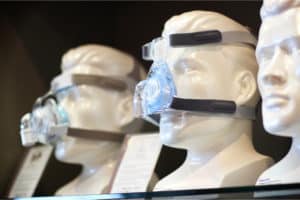Continuous Positive Airway Pressure

CPAP (Continuous Positive Airway Pressure), as the name implies, is the maintenance of a positive pressure in the airways throughout the complete respiratory cycle (inspiration and expiration), when breathing spontaneously.
Increased inspiratory pressure also increases the size and surface area of the alveoli providing greater opportunity for gas exchange to occur and improving oxygenation in the bloodstream. During the expiratory phase, breathing against a threshold of resistance holds the airway open, preventing air trapping.
This was originally used in pulmonary and cardiovascular conditioning of racehorses and competition animals.
CPAP therapy
 CPAP therapy uses machines and devices specifically designed to deliver a constant flow of pressure. CPAP devices use airflow to create a positive pressure in the oropharynx and laryngopharynx. The flow may be constant or varying based on the design, and most CPAP systems have an intentional outlet to vent the excess flow.
CPAP therapy uses machines and devices specifically designed to deliver a constant flow of pressure. CPAP devices use airflow to create a positive pressure in the oropharynx and laryngopharynx. The flow may be constant or varying based on the design, and most CPAP systems have an intentional outlet to vent the excess flow.
Types of CPAP
There are two main types of CPAP units based on the functionality.
Fixed CPAP units deliver a constant air flow whereas variable (auto adjusting) units titrate the flow throughout the night to optimize the pressure. Various devices are available for this purpose, and each device uses its own algorithm to set the flow.
Automatic adjustments (ACPAP) are considered more comfortable as they can adjust the flow according to the requirement of the individual.
CPAP interfaces

There are many manufacturers of CPAP devices who use their own interface or interfaces to connect the patient to the device. Most commonly used interfaces include the nasal mask, nasal pillows or the oronasal mask.
New technology has also been developed to combine the oral mask with nasal pillows to deliver the airflow to both upper respiratory openings. A full-face mask or whole head applications (CPAP helmets) are also used with varying degrees of success.
Each interface is held in place by head gear and straps around the head. Nasal CPAP is commonly used in children despite some controversies. Studies have shown that nasal CPAP reduces ventilator time, but an increased chance of developing pneumothorax (air in the pleural cavity) is also prevalent. Oral masks and naso-oral masks are often used when nasal congestion or obstruction is present.
Other CPAP features
In addition to these, some CPAP machines have other features like heated humidifiers. CPAP devices that combine nasal pressure with Maxillary Advancement Devices (MAD) also exist.
The best part of some CPAP machines comes with the fact that they make data sharing possible and absolutely simple. You can share the data with your healthcare provider with ease in real time and with simply a phone call the machine can be remotely adjusted.
CPAP effectiveness
CPAP is found to be effective in treating sleep disorders such as obstructive sleep apnea, hypopnea and sleep disturbances. It is also useful in helping patients mobilize secretions, prevent atelectasis, reduce air trapping in COPD, reduce severe asthma attacks and cardiogenic pulmonary edema and treat hypoxemia.
Some physicians may use CPAP in premature infants with respiratory distress syndrome as well.
Downsides of using CPAP
 There are some problems with CPAP devices that make the patients noncompliant. Main cause is the pressure points created on the forehead and the bridge of the nose. The discomfort caused by these pressure points on a long-term basis is significant and can, in turn, cause sleep disturbances.
There are some problems with CPAP devices that make the patients noncompliant. Main cause is the pressure points created on the forehead and the bridge of the nose. The discomfort caused by these pressure points on a long-term basis is significant and can, in turn, cause sleep disturbances.
Some nasal pillow systems and the oral mask/nasal pillow combination solve this issue but create a pressure point on the nares. Some patients dislike CPAP because it causes discomfort while swallowing when receiving positive pressure.
Also, if the patient opens his/her mouth while wearing a nasal mask or pillows, the flow from the CPAP constantly rushes out of the mouth. A chin strap can be used to stop this problem, but it may add to the discomfort of the patient.
CPAP Summary
All in all, CPAP is a great invention that has helped thousands of patients to overcome an array of respiratory related issues throughout the years. However, a significant number of patients have become noncompliant and missed out on the benefits of this invention owing to its minor drawbacks mentioned above.
Research and development is continuing to improve the functionality and user-friendliness of CPAP therapy to make it an invaluable, must-have asset in hospitals and at home.
References
Bill Pruitt, MBA, RRT, CPFT, AE-C. Clinical foundations; A Patient-focused Education Program for Respiratory Care Professionals.
Mercury medical. Continuous Positive Airway Pressure. 2014
Richard H. Blackmer, Jonathan W. Hedman. Method and apparatus for pulmonary and cardiovascular conditioning of racehorses and competition animals. 1988